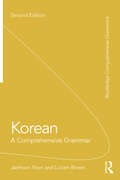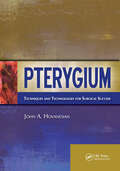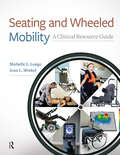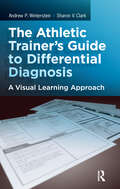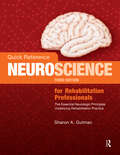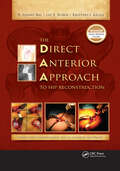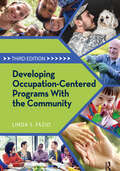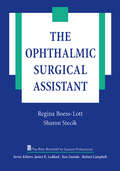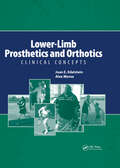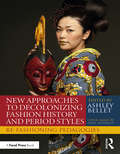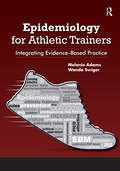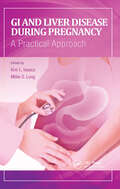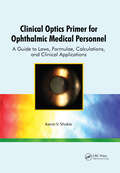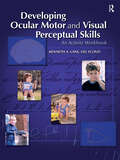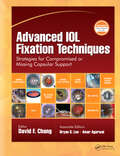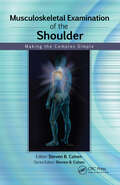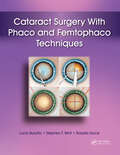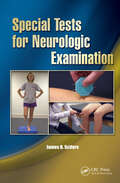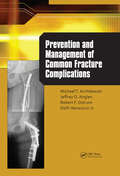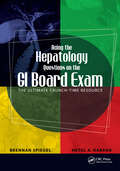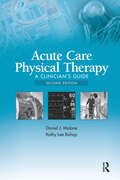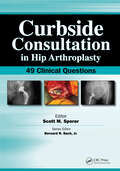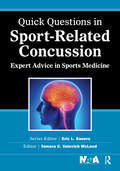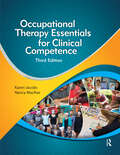- Table View
- List View
Korean: A Comprehensive Grammar (ISSN)
by Jaehoon Yeon Lucien BrownKorean: A Comprehensive Grammar is a reference to Korean grammar, and presents a thorough overview of the language, concentrating on the real patterns of use in modern Korean. The book moves from the alphabet and pronunciation through morphology and word classes to a detailed analysis of sentence structures and semantic features such as aspect, tense, speech styles and negation.Updated and revised, this new edition includes lively descriptions of Korean grammar, taking into account the latest research in Korean linguistics. More lower-frequency grammar patterns have been added, and extra examples have been included throughout the text.The unrivalled depth and range of this updated edition of Korean: A Comprehensive Grammar makes it an essential reference source on the Korean language.
Pterygium: Techniques and Technologies for Surgical Success
by John HovanesianPterygium surgery often presents a challenge to ophthalmic surgeons due to a high tendency for tissue re-growth. Pterygium: Techniques and Technologies for Surgical Success details the latest advances in ocular surface surgery, as well as new methods to overcome the traditional complications of pterygium surgery. Dr. John A. Hovanesian and his contributors address pterygium surgery through a detailed compilation of intraoperative and postoperative patient management. Pterygium: Techniques and Technologies for Surgical Success includes step-by-step details on a wide range of treatment therapies, such as:• Use of fibrin tissue adhesive• Conjunctival autograft techniques, including wide margin autograft• Amniotic membrane techniques and pearls• Mitomycin and 5FU Adjuncts• Conjunctival Chalasis• Postoperative complications management, including the surgical approach to recurrencesPterygium: Techniques and Technologies for Surgical Success is an indispensible resource for ophthalmic surgeons, residents, fellows, and assisting staff who must keep up with the latest ocular procedures regarding pterygium surgery.
Seating and Wheeled Mobility: A Clinical Resource Guide
by Michelle L. Lange Jean MinkelSeating and Wheeled Mobility: A Clinical Resource Guide presents clinical assessment considerations when working with a person with a disability who may need wheelchair seating for postural support, skin integrity, or a wheelchair base to best meet dependent or independent mobility needs.Michelle L. Lange and Jean Minkel have designed this text to support occupational and physical therapists, complex rehabilitation technology suppliers, and even third-party payers who are interested in wheelchair seating and mobility assessment and applications. Seating and Wheeled Mobility provides a wide spectrum of information from foundational information for those practitioners who are new to the field to in-depth, population-specific information for practitioners who perhaps have not worked with a particular population in the past.Information sharing, opportunities for demonstration and trial, and patience on the part of the clinician working with the person with a disability are all critical precursors to the actual process of making equipment recommendations.Seating and Wheeled Mobility is divided into sections, each addressing a different area of clinical practice. The first section is an in-depth presentation of the assessment process and the critical understanding of pressure management needed by the clinical team when working with a client population who rely on wheeled mobility. The second section focuses on postural support. Also included is a completely updated method to measure and describe the seated person and related support surfaces needed when recommending a device. The third section lays the foundation for clinical decision making around the assessment for and application of the most appropriate wheeled mobility device. The fourth section provides in-depth clinical applications for each category of mobility devices. Also addressed is proper documentation to assist in the funding of these devices. The fifth section provides population-specific information regarding the clinical application of position, pressure management, and functional mobility as it applies to the pediatric, geriatric, and bariatric populations, as well as persons with both degenerative and complex neuromuscular impairments. The last section presents additional considerations when working with persons who are aging with a disability, environmental assessments, transportation, and the application of standards. Seating and Wheeled Mobility: A Clinical Resource Guide provides the depth and breadth of the clinical practice of wheelchair seating and mobility to both those who are new to the field, as well as seasoned professionals.
The Athletic Trainer's Guide to Differential Diagnosis: A Visual Learning Approach
by Andrew P. Winterstein Sharon ClarkAs educators, we strive to teach students to think critically and to commit to a diagnosis, the ability to make that commitment is one of the most difficult steps for clinicians in training. With many possible injuries and conditions, and an equally large number of diagnostic elements, a clear and logical method is needed.The Athletic Trainer’s Guide to Differential Diagnosis: A Visual Learning Approach provides an approach that helps the reader sort through the possibilities and think about the clinical evaluation within a clinical thinking framework using a visual mapping approach.The Athletic Trainer’s Guide to Differential Diagnosis is not designed to be a “how-to” evaluation text. Rather, it is designed to create a framework that allows the reader to think differently about differential diagnoses, access existing knowledge in anatomy and clinical evaluation, and assess information for the purpose of making higher-order clinical decisions. Dr. Andrew P. Winterstein and Sharon V. Clark have organized The Athletic Trainer’s Guide to Differential Diagnosis by body part, as well as by location in the body. The reader will be able to examine the possible diagnoses by location and approach the evaluation in a more focused and organized fashion. This method of evaluation also allows the reader the opportunity to apply evidence-based principles to the clinical evaluation process.The Athletic Trainer’s Guide to Differential Diagnosis takes a visual learning approach with an emphasis on diagrams, tables, and boxes to illustrate the visual evaluation framework. In addition, each chapter offers a clinical case to provide a springboard for approaching the differential diagnosis process.The Athletic Trainer’s Guide to Differential Diagnosis: A Visual Learning Approach will enhance the athletic training student and clinician’s critical thinking skills, as well as be an excellent resource for self-assessment and preparation for certification.
Quick Reference NeuroScience for Rehabilitation Professionals: The Essential Neurologic Principles Underlying Rehabilitation Practice
by Sharon A. Gutman"Quick Reference NeuroScience for Rehabilitation Professionals: The Essential Neurologic Principles Underlying Rehabilitation Practice, Third Edition" is a user-friendly, comprehensive text that specifically addresses the key information needed to understand the neuroscience of clinical rehabilitation. A concise and quick reference for the practitioner and student who are learning or reviewing the most relevant neuroscience principles supporting rehabilitation therapy. The updated third edition continues to meet a need in the rehabilitation profession that has gone unfilled - the ability to break down neuroscience information into the essential principles that can be used to understand neurological conditions and the principles underlying rehabilitation evaluation and practice. This fully-updated third edition provides a quick review of specific neuroscience concepts and principles that support rehabilitation interventions.In this era of information overload, this text rapidly and thoroughly provides condensed information in a user-friendly, easy-to-use format for readers to review and convey relevant information to patients. Sharon Gutman has organised the text into three parts: the first addresses neuroanatomy; the second addresses the function of neurological systems underlying physical, psychiatric, cognitive, and visual perceptual disorders; and the final section addresses clinical neuropathology related to ageing, addiction, memory, and the neurological substrates of sex and gender. A specific section describes the common neurodiagnostic tests that therapists do not administer but must have knowledge of when results are discussed at treatment team meetings.Features of the third edition: Presented in a simple and organised bulleted format. Large-scale colour illustrations to easily visualise neuroanatomical structures and systems. Text boxes to apply key neuroscience concepts to the understanding of common neurological disorders and treatment. Updated clinical test questions and glossary. The third edition bridges a gap by quickly providing the rehabilitation professional with the most salient information needed to understand neurologic principles underlying rehabilitation practice.
The Direct Anterior Approach to Hip Reconstruction
by B. Bal Lee Rubin Kristaps KeggiTotal hip arthroplasty has steadily evolved to improve patient outcomes and safety. One innovation has been to incorporate less invasive surgical methods, such as the direct anterior surgical approach. The Direct Anterior Approach to Hip Reconstruction is a comprehensive reference text that addresses contemporary surgeon interest in innovation and less invasive surgery. This resource will help with introductory learning, intermediate technical development, and advanced revision total hip skills using the direct anterior technique. Accordingly, the text is structured into three sections as follows: Basic concepts: Surgical hip anatomy, patient selection, and placement of single, multiple, and extensile incisions for primary total hip arthroplasty Intermediate concepts: Adoption of imaging and navigation technologies, use of traction tables to enhance positioning, and presentation of unique instruments and custom devices that have evolved specifically for the direct anterior approach Advanced concepts: Using the direct anterior approach for bearing and liner exchanges, acetabular revisions, femoral component revisions, and both component revisions. Drs. B. Sonny Bal, Lee E. Rubin, and Kristaps J. Keggi have combined their unique perspectives, along with those of a renowned group of North American and European experts in the anterior hip reconstruction surgery to create this reference. Dr. Keggi was among the first to recognize the benefits of the direct anterior approach in hip reconstruction; this text is based on his 50-plus years of experience as a clinician and pioneer surgeon. The Direct Anterior Approach to Hip Reconstruction provides a stepwise learning process for surgeons interested in mastering total hip arthroplasty using the direct anterior approach, with detailed chapters and video instruction, contributed by a distinguished group of international experts in the field.The chapters focus on using the direct anterior approach to address a variety of hip problems well beyond performing total hip arthroplasty for osteoarthritis. The unique applications of the direct anterior approach within the orthopedic sub-specialties are addressed in chapters covering the fields of pediatrics, sports medicine, trauma, and tumor surgery. Other chapters address subjects like femoroacetabular impingement, hip preservation surgery, and postoperative rehabilitation protocols designed to improve patient outcomes.The final section of the text reviews the evidence-based outcomes related to direct anterior total hip arthroplasty, addressing evolving implant design concepts specific to this approach, and outlining directions for educating the next generation of surgeons who will continue to develop and refine these techniques. Complementing the written text is a website with educational videos to further enhance the learning experience.To date, no other reference has addressed the need for comprehensive education for the orthopedic resident, fellow, or surgeon seeking to learn about the direct anterior approach for hip reconstruction. This resource should be invaluable to orthopedic surgeons worldwide and will contribute to improving patient safety, reducing complications, and better surgical outcomes. Indeed, this landmark publication is truly the world’s first comprehensive text on anterior hip surgery.
Developing Occupation-Centered Programs With the Community
by Linda FazioThe updated Third Edition of Developing Occupation-Centered Programs With the Community continues to provide an excellent step-by-step workbook approach to designing and implementing a program for the community.Inside Developing Occupation-Centered Programs With the Community, Third Edition, Dr. Linda Fazio includes the importance of community asset identification and development toward sustainability.The Third Edition includes new and updated content on evidence-based practice; program evaluation at multiple levels; funding; nonprofits and social entrepreneurship. Additionally, new trending issues of interest to programmers include human trafficking, post-combat programming for military veterans and their families, arts-based programming for all ages, and programming to meet current needs of the well-elderly.Features of the Third Edition: Workbook format offers the instructor and the student options for how to use the text in a classroom or independently in an internship or residency. The order of the programming process, chapter content order, summaries, and format of exercises has been retained to ease transition for instructors using previous editions of the text. The program “story” section has been retained, along with author’s notes on what is currently happening with these programs and other related topic areas New content has been added in program sustainability, the assessment and building of community assets, and consensus organizing in communities. More developed content is offered about the structure and function of nonprofit organizations as well as the role and function of the social entrepreneur who does programming for these organizations. Included with the text are online supplemental materials for faculty use in the classroom.Developing Occupation-Centered Programs With the Community, Third Edition is an excellent introductory tool and is a valuable resource for occupational therapy students at all levels, as well as experienced practitioners in a clinical setting.
The Ophthalmic Surgical Assistant (The Basic Bookshelf for Eyecare Professionals)
by Regina Boess-Lott Sharon StecikThe Basic Bookshelf for Eyecare Professionals is a series that provides fundamental and advanced material with a clinical approach to clinicians and students. A special effort was made to include information needed for the certification exams in ophthalmic and optometric assisting, as well as for surgical assistants, opticians, plus low vision, and contact lens examiners.This book contains basic guidelines and typical scenarios that the ophthalmic surgical assistant needs to know. The text begins with the operative patient, including preoperative testing and consents, and travels through the operating room experience. Topics include gowning and gloving, preparing trays and tables, and sterilization techniques. Detailed descriptions of common operative procedures such as plastics, cataract, corneal, and retinal procedures are also included. Operative notes are written on a minute-by-minute basis so the reader can become familiar with the instruments and other implements, and the order in which they are used. This text will help prepare the ophthalmic assistant for any setting, whether it be hospital or office based.
Lower-Limb Prosthetics and Orthotics: Clinical Concepts
by Joan Edelstein Akex MorozLower-Limb Prosthetics and Orthotics: Clinical Conceptsis a comprehensive overview of lower-limb prosthetics and orthotics, covering normal and pathological gait, lower-limb biomechanics, clinical applications, as well as prosthetic and orthotic designs and components. Joan Edelstein and Alex Moroz have writtenLower-Limb Prosthetics and Orthotics with the clinician’s perspective in mind. Clinical management is incorporated throughout the text, including basic surgical concepts, postoperative management, preprosthetic care, and training in the use of devices. Additionally, this text incorporates unique features relevant to physicians such as prescription writing and prosthetic and orthotic construction and modification, as well as, the latest research regarding energy consumption and long-term utilization of prostheses.Chapters Include: Orthotics in neuromuscular diseases Orthotics in pediatrics Functional expectations Gait and activities training Transtibial and transfemoral prostheses and components Transtibial and transfemoral biomechanics, evaluation, and gait analysis Disarticulations and Bilateral Amputations With over 150 line drawings and photographs to supplement the text, Lower-Limb Prosthetics and Orthotics: Clinical Concepts is ideal for clinicians in the fields of physical medicine and rehabilitation, orthopedics, vascular surgery, physical therapy and occupational therapy.
New Approaches to Decolonizing Fashion History and Period Styles: Re-Fashioning Pedagogies
by Ashley BelletNew Approaches to Decolonizing Fashion History and Period Styles: Re-Fashioning Pedagogies offers a wide array of inclusive, global, practical approaches for teaching costume and fashion history.Costume designers, technicians, and historians have spent the last several years re-evaluating how they teach costume and fashion history, acknowledging the need to refocus the discourse to include a more global perspective. This book is a collection of pedagogical methods aimed to do just that, with an emphasis on easy reference, accessible activities, and rubrics, and containing a variety of ways to restructure the course. Each chapter offers a course description, syllabus calendar, course objectives, and learning outcomes, as well as sample activities from instructors across the country who have made major changes to their coursework. Using a combination of personal narratives, examples from their work, bibliographies of helpful texts, and student responses, contributors suggest a variety of ways to decolonize the traditionally Western-focused fashion history syllabus.This collection of pedagogical approaches is intended to support and inspire instructors teaching costume design, costume history, fashion history, period styles, and other aesthetic histories in the arts.
Epidemiology for Athletic Trainers: Integrating Evidence-Based Practice
by Melanie Adams Wanda SwigerEvidence-based practice requires clinicians to be knowledgeable of the current standards of care and be willing to consider the effectiveness of new methods. Athletic Trainers especially must understand how epidemiology shapes healthcare practices for physically active patients.To meet this need, Epidemiology for Athletic Trainers: Integrating Evidence-Based Practice is a succinct and comprehensive reference meant to develop and refine student and clinician evidence-based practice skills. This text addresses the prevalence, risk factors, and surveillance of sports-related injury and illness at youth, college, and professional levels.Inside Epidemiology for Athletic Trainers: Integrating Evidence-Based Practice, Drs. Wanda Swiger and Melanie M. Adams guide the reader through the steps of evidence-based practice by presenting basic research and statistical methods needed to read medical literature. Key sport epidemiology studies are reviewed for both historical and clinical significance. This foundation is built on with a deeper discussion of injury and illness prevention and future research. Chapters cover a wide range of topics including the health benefits of physical activity, concussion return to play guidelines, ACL prevention, and mental health concerns. This text provides an exceptional approach to integrating evidence-based practice skills with clinical practice.Features: Meets the Commission on Accreditation of Athletic Training Education (CAATE) outcomes Includes classroom activities to make the text interactive and expand the student’s or clinician’s research skills Fosters the use of prevention practices and health promotion within athletic training Included with the text are online supplemental materials for faculty use in the classroom.Epidemiology for Athletic Trainers: Integrating Evidence-Based Practice is a must-have for any athletic training student or clinician looking to improve his or her decision-making skills within an evidence-based context.
GI and Liver Disease During Pregnancy: A Practical Approach
by Kim Isaacs Millie LongGI and Liver Disease During Pregnancy: A Practical Approach by Drs. Kim Isaacs and Millie D. Long is a unique handbook focusing on common gastrointestinal symptoms and diseases seen in pregnant patients. Each chapter addresses the diseases or symptoms and focuses on key questions to ask the patient and key points regarding diagnosis and management. This handbook is organized to have each chapter focus on a common complaint or discrete disease, making it easy to find exact information in a ready reference. Also provided are tables of drug safety during pregnancy and breast feeding. Unique features also include a section on alternative therapies and a chapter on care in post bariatric surgery patients.Each Chapter Covers:· Epidemiology· Pathology· Presentation and Evaluation· Management · Summary· Key PointsPocket-sized and easy to read, GI and Liver Disease During Pregnancy: A Practical Approach is a convenient and accessible reference for gastroenterology fellows, OB/GYN fellows and residents, and practicing gastroenterologists.
Illustrative Guide to Cataract Surgery: A Step-by-Step Approach to Refining Surgical Skills
by Amar AgarwalIllustrative Guide to Cataract Surgery by Editor, Dr. Amar Agarwal and Associate Editor, Soosan Jacob is a unique book that includes matching step-by-step clinical photographs, medical illustrations, and videos to explain the most common techniques and steps in cataract surgery. With more than 650 illustrations, ophthalmologists and residents will visually learn the most essential procedures in cataract surgery, step-by-step.The content, comprised from leading ophthalmic surgeons, is structured into systematically divided sections such as phaco surgery, microincision cataract surgery, challenging cases, and complications. It allows for quick reference, without having to search through voluminous books. Each image is supplemented with concise, informative text that helps further explain the techniques.In addition, video instruction is offered through a companion website, with each book purchase. Using the same approach as the book, the website presents videos that match each technique or step in cataract surgery.Just a few of the procedures explained:• Vertical chopping• Biaxial microincisional cataract surgery• Posterior polar cataract• Iris hooks in small pupil phaco• Subluxated cataracts• Torn rhexis• Glued IOL implantation• Intraocular lens implantationWith a combination of matching photos and illustrations alongside brief text and companion website, Illustrative Guide to Cataract Surgery stands apart from traditional books.
Clinical Optics Primer for Ophthalmic Medical Personnel: A Guide to Laws, Formulae, Calculations, and Clinical Applications
by Aaron ShuklaAre you looking for an all-inclusive, comprehensive resource on clinical optics? Look no further than the Clinical Optics Primer for Ophthalmic Medical Personnel: A Guide to Laws, Formulae, Calculations, and Clinical Applications, a new text that presents complex clinical optics in a simple and easy-to-read manner. As ophthalmic medical personnel struggle today between multiple resources for clinical optics, this text offers a solution as it provides everything you need to know – all in one place. Aaron V. Shukla, PhD, COMT has designed Clinical Optics Primer for Ophthalmic Medical Personnel to include everyday examples that may be directly applied to clinical work. Each chapter throughout the text explains one optics concept in a concise account and includes applicable illustrations, formulae, laws, calculations, and review questions. Numerous examples of clinical applications are also included that address problems presented by patients in eye clinics.Some important laws of optics and their clinical applications covered: Lasers, polarization interference, and fluorescence Snell’s law Total internal reflection Some important formulae in optics and their clinical applications covered: Vergence equation Power of prisms Optical system of the eye Accommodation and age Refractive errors Prentice’s Rule, decentration and induced prism Glasses and contact lenses With the most up-to-date information for clinical optics, and two chapters solely devoted to the metric system and basic optical mathematics, Clinical Optics Primer for Ophthalmic Medical Personnel: A Guide to Laws, Formulae, Calculations, and Clinical Applications is essential for all ophthalmic assistants, technicians, and technologists, as well as optometrists and ophthalmology residents.
Developing Ocular Motor and Visual Perceptual Skills: An Activity Workbook
by Kenneth LaneWith over 20 years of experience, Dr. Kenneth A. Lane has designed Developing Ocular Motor and Visual Perceptual Skills: An Activity Workbook to help occupational therapists, optometrists, and other professionals develop the ocular motor and visual perceptual skills of learning disabled children. To establish a framework for understanding, each chapter begins with the scientific theories used to develop the activity forms. Insightful suggestions are included on how to solidify the program's success. The easy-to-follow activity forms are then presented, along with numerous illustrations that help develop ocular motor and visual perceptual skills. The forms are divided into as many as five levels of difficulty so both children and teenagers can benefit from each activity. Developing Ocular Motor and Visual Perceptual Skills contains daily lesson plans and practical tips on how to successfully start an activities program. Other helpful features include a glossary of terms and a reference list of individuals and organizations that work with learning disabled children to develop these skills.The first of its kind, Developing Ocular Motor and Visual Perceptual Skills utilizes a learning approach by linking the theories with the remediation activities to help learning disabled children improve their perceptual and fine motor skills. All professionals looking to assess and enhance a variety of fine motor and visual perception deficiencies will welcome this workbook into their practices. Topics include: Complexity of reading Ocular motor Gross motor Visual-motor perception Visual memory Laterality Reversals
Advanced IOL Fixation Techniques: Strategies for Compromised or Missing Capsular Support
by David F. ChangAbnormal or deficient capsular anatomy creates numerous surgical challenges and predisposes eyes to IOL complications. Literally dozens of different approaches have been devised to implant IOLs in the face of compromised capsular support. However, a comprehensive compendium of the most important surgical strategies has not existed, until now.Advanced IOL Fixation Techniques:Strategies for Compromised or Missing Capsular Support provides this much-needed resource with more than 70 different chapters that cover the wide array of surgical approaches. Among the contributors are many of the original innovators of the most important technologies and methodologies. In addition to teaching a specific surgical technique, these authors cover its history, rationale, and clinical results. Editor Dr. David F. Chang is well known and acclaimed for 2 best-selling cataract textbooks—Mastering Refractive IOLs and Phaco Chop and Advanced Phaco Techniques. Along with associate editors Drs. Bryan S. Lee and Amar Agarwal, Dr. Chang has now tackled this new major subject area—how to best fixate IOLs when capsular support is compromised or absent. Part One covers capsular fixation with either zonulopathy or following posterior capsule rupture. Topics include using conventional and modified capsular tension rings, capsular tension segments or capsular anchors, standard and reverse optic capture with anterior capsulorrhexis, sulcus fixation, posterior capsulorrhexis, and capsular membrane suture fixation. Part Two covers noncapsular fixation. Topics include anterior chamber IOLs, iris claw IOLs, iris and transscleral suture fixation of posterior chamber IOLs, and intrascleral haptic fixation using the Yamane double-needle or glued IOL methods. Part Three covers miscellaneous topics such as anterior vitrectomy, IOL power calculation for noncapsular IOLs, and sliding slip knots and suture pupilloplasty. To facilitate skills transfer, most chapters present detailed, step-by-step descriptions of the different techniques. The maneuvers are illustrated by over 1,100 diagrams and high-resolution surgical images. Finally, nearly every chapter is accompanied by narrated instructional videos. Combining over 150 videos, schematic diagrams, surgical images, and detailed written descriptions, Advanced IOL Fixation Techniques provides the most effective way to learn advanced surgical techniques. With its comprehensive and practical approach to covering the gamut of strategies and devices, Advanced IOL Fixation Techniques:Strategies for Compromised or Missing Capsular Support will be an indispensable resource for cataract surgeons at all levels of experience.
Musculoskeletal Examination of the Shoulder: Making the Complex Simple
by Steven CohenThe physical examination of the shoulder can be a complex topic for professionals with all levels of clinical experience. How can advance concepts be taught in a user-friendly, clear format, while still providing necessary information for effective diagnosis and treatment of the shoulder?Musculoskeletal Examination of the Shoulder: Making the Complex Simple by Dr. Steven B. Cohen answers these questions. Written by experts, this easy-to-carry book provides a thorough review of the most common pathologic shoulder conditions, techniques for diagnosis, as well as the appropriate treatment for each condition.Musculoskeletal Examination of the Shoulder: Making the Complex Simple contains clear photographic demonstrations, tables, and charts throughout its pages, allowing a thorough and concise examination of the shoulder.A glance at some of what is covered inside:• Physical Examinationo Basics and specific tests of the physical examination of the shoulder• General Imagingo Basics of general imaging of the shoulder• Common Conditions o Superior labrar tears, Biceps tendon, Glenohumeral arthritis, and moreMusculoskeletal Examination of the Shoulder: Making the Complex Simple contains essential information to successfully take a complex subject and bring it to a level that will be welcomed by orthopedic residents, attendings, physical therapists, athletic trainers, medical students in training, and other health care providers.
Cataract Surgery With Phaco and Femtophaco Techniques
by Lucio Buratto Stephen Brint Rosalia SorceCataract Surgery With Phaco and Femtophaco Techniques offers a unique insight into the evolution of phacoemulsification machines and the development of new ways to supply energy, as well as new devices that improve fluidics therefore increasing the safety of the phaco and femtophaco surgical procedures. Dr. Lucio Buratto, Dr. Stephen Brint, and Dr. Rosalia Sorce provide a step-by-step approach to everything the surgeon must learn about the physical principles that regulate the fluidics and energy to understand the machine’s working during the surgical procedure. Cataract Surgery With Phaco and Femtophaco Techniques covers a wide variety of topics, including anterior chamber phacoemulsification, endocapsular techniques, irrigation and aspiration, fluidics and pumps, and principles of femtosecond cataract surgery. Supplemented by more than 300 color illustrations, diagrams, a glossary, and references, all surgeons from beginner to expert will want this unique resource by their side.
Special Tests for Neurologic Examination
by James ScifersIdeal for students and clinicians to access quick clinical information, Special Tests for Neurologic Examination offers invaluable evaluation and assessment tips and techniques for neurologic conditions commonly found in patients. Organized in an easy-to-use format, this book is the perfect guide for practicing clinical skills and reviewing for licensure and certification examinations.Dr. James R. Scifers describes and illustrates special tests for the upper extremity, lower extremity, and spine. This resource provides performance criteria for each special test, important information on specificity and sensitivity, and valuable references for further investigation. Inside you’ll find: • Techniques for dermatome, myotome, reflex screening, and concussion testing • Examples of various concussion grading scales and neuropsychological tests • Special design that facilitates use of the book as a user-friendly study guide and quick clinical reference • Data on test specificity and sensitivity to assist clinicians in determining the value and strength of various clinical examination procedures • Additional resources for further study and exploration A facilitative and comprehensive approach to learning, practicing, and reviewing neurologic special tests makes Special Tests for Neurologic Examination a must-have for students and clinicians alike. With a focus on commonly used evaluative procedures for differentiating and diagnosing neurologic disorders, the book serves as a valuable companion to the popular Special Tests for Orthopedic Examination.
Prevention and Management of Common Fracture Complications
by Dolfi Herscovici Michael Archdeacon Jeff Anglen Robert OstrumEvery orthopedic surgeon faces complications in the management of fractures. Drs. Michael T. Archdeacon, Jeffrey O. Anglen, Robert F. Ostrum, and Dolfi Herscovici, Jr. have created Prevention and Management of Common Fracture Complications, a comprehensive reference dedicated entirely to the prevention and management of fracture complications. Prevention and Management of Common Fracture Complications is arranged on an anatomic basis with contributions from more than 45 orthopedic surgeons. Each contributor is considered an expert on the topic covered in their respective sections of the book.Some Chapters Include:• The etiological factors for each complication• Strategies for preventing the complication• Surgical techniques• Reduction and implant selection• Strategies required to successfully manage the complicationPrevention and Management of Common Fracture Complications also includes more than 300 images and more than 45 tables.Prevention and Management of Common Fracture Complications offers a single and complete resource to readily answer all fracture complication questions and is ideal for orthopedic surgeons, orthopedic residents, and medical students interested in orthopedic surgery.
Acing the Hepatology Questions on the GI Board Exam: The Ultimate Crunch-Time Resource
by Brennan Spiegel Hetal KarsanHepatology is an expanding field - it's hard to keep up. The liver has been sitting there the whole time, but the knowledge surrounding this perplexing organ is exploding; this makes it hard to prepare for board and recertification exams, where 1 in every 4 questions pertains to hepatology. Until now, there has been no single, slim, but high-yield volume that summarises the hepatology you need to know for the boards. This book has it nailed. The authors have collected every pearl of wisdom, high-yield factlet, liver ""board buzzword,"" hepatic micrograph, and classic liver imaging study they could muster, all while keeping the book a manageable size - because who has time for more than manageable when you're busy?The answer to your study questions (and study time!) can be found inside: Acing the Hepatology Questions on the GI Board Exam: The Ultimate Crunch-Time Resource.Traditional textbooks usually feature long and detailed discussions that are not directly related to Board and recertification exams. On the flip side, many Board review manuals provide lists and bullet points lacking sufficient background and context. Inside Acing the Hepatology Questions on the GI Board Exam, Drs. Brennan Spiegel and Hetal Karsan present time-tested and high-yield information in a rational, useful, and contextually appealing format.With its focus on pearl after pearl, emphasis on images, and attention to high-yield "tough stuff" vignettes you don't know the answers to (yet), Acing the Hepatology Questions on the GI Board Exam is truly the ultimate crunch-time resource for acing often vexing liver section of the examination, taking recertifying examinations, looking good on clerkship rounds, or for just challenging yourself with interesting and entertaining vignettes.
Acute Care Physical Therapy: A Clinician’s Guide
by Daniel J. Malone Kathy Lee BishopAcutely ill patients are found in the hospital, in the skilled nursing facility, in inpatient rehabilitation facilities, in outpatient practices, and in the home. The role of the physical therapist and physical therapist assistant is to rehabilitate these vulnerable and frail patients to enhance their health and functioning. The goal of Acute Care Physical Therapy: A Clinician’s Guide, Second Edition is to provide the acute care practitioner with the necessary knowledge to improve patients’ structural impairments and activity limitations so they can more successfully participate in life. Nothing could be more challenging and rewarding. Inside, Drs. Daniel Malone and Kathy Lee Bishop, along with their contributors, provide a comprehensive review of acute care physical therapist best practice. This text builds upon fundamental knowledge by addressing important components of the patient examination ranging from the patient’s medical history to laboratory testing to life supporting equipment. Following this introduction, each chapter highlights specific organ systems with a review of pertinent anatomy and physiology followed by common health conditions and medical management. Important physical therapy concerns, examination findings, and rehabilitation interventions are discussed in detail. This Second Edition includes numerous tables, figures, review questions, and case studies that highlight clinical reasoning and the physical therapy patient care model as outlined in the Guide to Physical Therapist Practice. New in the Second Edition: Increased focus on evidence-based examination, evaluation, and intervention The latest technology in physiologic monitoring and patient support equipment Introduces the “PT Examination” and “ICU” algorithms to promote safe and progressive rehabilitation Emphasis on clinical decision making through the application of a clinical reasoning model applied to the end of chapter cases Acute Care Physical Therapy: A Clinician’s Guide, Second Edition will serve as a valuable education tool for students, newer professionals as well as post-professionals who provide therapy services to the acutely ill patient regardless of setting.
Curbside Consultation in Hip Arthroplasty: 49 Clinical Questions (Curbside Consultation in Orthopedics)
by Scott SporerAre you looking for concise, practical answers to those questions that are often left unanswered by traditional hip arthroplasty references? Are you seeking brief, evidence-based advice for complicated cases or controversial decisions? Curbside Consultation in Hip Arthroplasty: 49 Clinical Questions provides quick answers to the thorny questions most commonly posed during a “curbside consultation” between orthopedic surgical colleagues. Dr. Scott Sporer has designed this unique reference which offers expert advice, preferences, and opinions on tough clinical questions commonly associated with hip arthroplasty. The unique Q&A format provides quick access to current information related to hip arthroplasty with the simplicity of a conversation between two colleagues. Numerous images, diagrams, and references are included to enhance the text and to illustrate the management of the hip.Curbside Consultation in Hip Arthroplasty: 49 Clinical Questions provides information basic enough for residents while also incorporating expert advice that even high-volume clinicians will appreciate. Practicing orthopedists, orthopedic residents, and non-physician personnel will benefit from the user-friendly and casual format and the expert advice contained within.Some of the questions that are answered: How do you treat a young patient with severe hip arthritis? When should they be indicated for surgery? What type of components should I use? What should I do when I suspect a patient has an infected hip? When do I need to remove his/her prosthesis? How do I treat a fracture of the femur when it occurs with surgery? several years post-surgery? What should I tell a patient that has persistent pain following a hip replacement and how should they be evaluated? How can I determine the severity of acetabular and femoral bone loss? What should I do to reconstruct the deficient bone?
Quick Questions in Sport-Related Concussion: Expert Advice in Sports Medicine (Quick Questions in Sports Medicine)
by Tamara McLeodAre you looking for concise, practical answers to questions that are often left unanswered by traditional sports medicine references? Are you seeking brief, up-to-date, expert advice for common issues that can be encountered when working with athletes?Quick Questions in Sport-Related Concussion: Expert Advice in Sports Medicine provides a unique format of concise and to the point responses with clinical application, backed by the latest research on sport-related concussions among athletes. Dr. Tamara C. Valovich McLeod and her contributors present 39 common clinical questions and answers based on the author’s experience and the many different guidelines, consensus, and position statements that have garnered increased attention in the media and literature. Co-published with the National Athletic Trainers’ Association, Quick Questions in Sport-Related Concussion: Expert Advice in Sports Medicine provides concise answers to 39 frequently asked clinical questions. Written in a conversational tone, the authors of the individual questions represent a variety of different backgrounds and are experts in their respective field. The variety of questions and brevity of responses will make this a book that is easy to read and reference at the point of care.Some sample sections and questions include: Concussion BasicsWhat are the best educational materials available to help a coach, parent, or athlete learn about concussions? Pre-Season PlanningWhat are the most important regulations and policies to consider regarding the management of sport-related concussion? Concussion assessmentHow common are vestibular deficits following sport-related concussion and what tools are best used to assess vestibular function? Concussion management considerationAre there any rehabilitation exercises you can do to help a concussed athlete heal faster? Return to activityWhat is the role of the graded exertion protocols for making RTP decisions? Return to schoolWhat is cognitive rest and can it help recovery following concussion? Quick Questions in Sport-Related Concussion: Expert Advice in Sports Medicine is the perfect at-your-side resource for the athletic trainer, team physician, or sports medicine clinician looking for practical answers to sport-related concussion questions. The concise and conversational tone allows the reader to readily apply the information into their everyday practice.
Occupational Therapy Essentials for Clinical Competence
by Karen Jacobs Nancy MacRaeOccupation, theory-driven, evidence-based, and client-centered practice continue to be the core of the profession and are the central focus of Occupational Therapy Essentials for Clinical Competence, Third Edition.The Third Edition contains updated and enriched chapters that incorporate new perspectives and evidence-based information important to entry-level practitioners. The Third Edition continues to relate each chapter to the newest ACOTE Standards and is evidence-based, while also addressing the guidelines of practice and terms from the AOTA’s Occupational Therapy Practice Framework, Third Edition.Dr. Karen Jacobs and Nancy MacRae, along with their 61 contributors, introduce every topic necessary for competence as an entry-level practitioner. Varied perspectives are provided in each chapter with consistent references made to the relevance of certified occupational therapy assistant roles and responsibilities.Additionally, chapters on the Dark Side of Occupation and Primary Care have been added to broaden the foundational scope of knowledge. Each chapter also contains a clinical case used to exemplify relevant content.New in the Third Edition: All chapters have been updated to reflect the AOTA’s Occupational Therapy Practice Framework, Third Edition Updated references and evidence-based practice chart for each chapter Updated case studies to match the current standards of practice References to the Occupational Therapy Code of Ethics (2015) Faculty will benefit from the multiple-choice questions and PowerPoint presentations that coincide with each chapter Included with the text are online supplemental materials for faculty use in the classroom.Occupational Therapy Essentials for Clinical Competence, Third Edition is the perfect multi-use resource to be used as an introduction to the material, while also serving as a review prior to sitting for the certification exam for occupational therapists and occupational therapy assistants.
